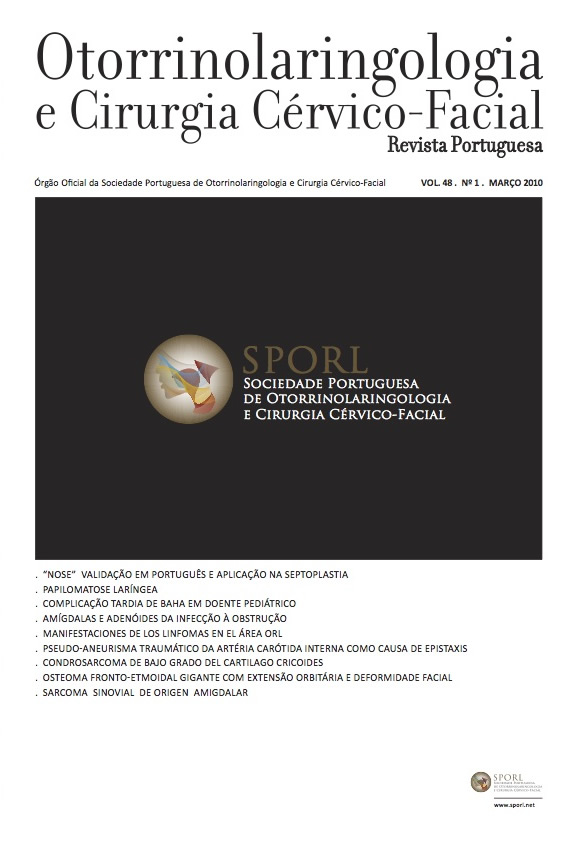Pseudo-aneurisma traumático da artéria carótida interna como causa de epistaxis
DOI:
https://doi.org/10.34631/sporl.261Palavras-chave:
Epistaxis, pseudo-aneurisma, artéria carótida interna, terapêutica endovascularResumo
O pseudo-aneurisma traumático da carótida interna é uma das causas raras de epistaxis, que pode ser fatal se não diagnosticado e tratado atempadamente. Os autores relatam o caso clínico de um jovem com pseudo-aneurisma da carótida interna que se apresentou com epistaxis grave, 11 anos após traumatismo crânio-facial.
Foi feita embolização do pseudo-aneurisma com coils, com sucesso e sem sequelas neurológicas.
Downloads
Referências
Gicquel P et al. Epistaxis. Encycl Méd Chir (Elsevier Paris). Oto-rhino- laryngologie. 1995;20-310-A10:p8
Holger J. Epistaxis: a clinical study of 1724 patients. J Laryngol Otol 1974; 88: 317-27
Chaboki H et al. Cavernous carotid aneurysm presenting with epis- taxis. Head & Neck 2004 Aug; 741-746.
Wang A et al. Traumatic internal carotid artery aneurysm with rup- ture into the sphenoid sinus. Surg Neurol 1986; 25: 77-81.
Ramos A et al. Traumatic aneurysm of the internal carotid artery: A late finding presenting as a mass in the sphenoid sinus. AJNR Am J Neuroradiol 1996 Feb; 17: 222-225.
Lima A et al. Défice visual pós traumático com agravamento tardio associado a aneurisma da artéria carótida interna cervical. Acta Médica Portuguesa 1994; 7: 483-486.
Chen D et al. Epistaxis originating from traumatic pseudoaneurysm of the internal carotid artery: Diagnosis and Endovascular therapy. Laryngoscope 1998 Mar; 108: 326-331.
Van Alyea OE. Nasal sinuses: an anatomical and clinical considera- tion, 2nd ed. Baltimore: Williams & Wilkins, 1951.
Renn WH, Rhoton AL. Microsurgical anatomy of the sellar region. J Neurosurg 1975 Sep; 43(3): 288-98.
Maurer JJ, Mills M, German WJ. Triad of unilateral blindness orbi- tal fractures, and massive epistaxis after head injury. J Neurosurg 1961; 18: 837- 40.
Seftel DM, Kolson H, Gordon BS. Ruptured intracranial aneurysm with fatal epistaxis. Arch Otolaryngol 1959; 70: 52-60.
Han MH et al. Traumatic pseudoaneurysm of the intracavernous ICA presenting with massive epistaxis: imaging diagnosis and envovascular treatment. Laryngoscope 1994 Mar; 104: 370-377.
Fleisher AS, Patton JM, Tindall GT. Cerebral aneurysms of traumatic origin. Surg Neurol 1975; 4: 233-9.
Simpson RK Jr, Harper RL, Bryan RN. Emergency baloon occlusion for massive epistaxis due to traumatid carotid-cavernous aneurysm. J Neurosurg 1988; 68: 142-4.
Chambers EF et al. Traumatic aneurysm of cavernous internal caro- tid artery with secondary epistaxis. AJNR Am J Neuroradiol 1981. 2: 405-409.
Handa J, Handa H. Severe epistaxis caused by traumatic aneurysm of cavernous carotid artery. Surg Neurol 1976; 5: 241-3.
Brilstra EH, Rinkel GJ, van der Graaf Y, van Rooij WJ, et al. Treatment of intracranial aneurysms by embolization with coils. Stroke. 1999; 30: 470-76.






